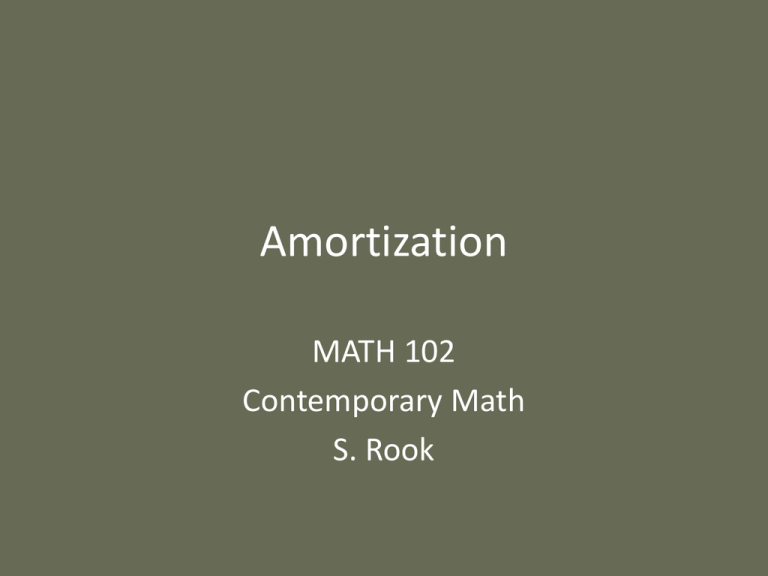ppt
advertisement

Amortization MATH 102 Contemporary Math S. Rook Overview • Section 9.5 in the textbook: – Amortized loans – Amortization schedules – Finding the unpaid balance on a loan Amortized Loans Amortized Loans • Amortized loan: a special type of loan that is paid off by making a series of regular & equal payments – Part of each payment goes towards paying off the simple interest from the unpaid balance while the rest goes towards paying off the principal of the loan – This differs from installment loans where the interest over the lifetime of the loan is computed at purchase • Interest for an amortized loan is computed on the unpaid balance Size of Payment for an Amortized Loan • To find the regular payment per month for an r amortized loan: 1 1 nt nt – Use the formula: r P 1 R n n r n • DO NOT be intimidated by this formula!!! – The left side is the compound interest formula (Section 9.2) while the right side is the formula to compute an annuity Size of Payment for an Amortized Loan (Continued) – Theory for the formula can be found on page 431 of the textbook: • Essentially, each payment can be thought of going into a sink fund • The amortized loan is paid off when the value of the sink fund (right side) equals or exceeds that of the compounded original principal computed by the lender (left side) • Again, DO NOT be intimidated by the formula – Calculate in steps • For some, the calculation may be further simplified by using a TI-xx calculator Amortized Loans (Example) Ex 1: Find the monthly payment required for each amortized loan: a) Amount, $5,000; rate, 10%; time, 4 years b) Amount, $8,000; rate, 7.5%; time, 6 years Amortized Loans (Example) Ex 2: Wilfredo bought a new boat for $13,500. He paid a $2,000 down payment and financed the rest for 4 years at an interest rate of 7.2%. a) Find his monthly payment b) Calculate the total amount of interest he will pay off over the lifetime of the loan Amortization Schedules Amortization Schedules • An amortization schedule (table) is a breakdown of how payments are used to pay interest and principal – Each row of the table represents a payment • Calculate the payment per month for the amortized loan (see previous slides) – e.g. Find the payments for a $1200 loan at 9.6% for 5 years • For each payment: – Calculate the interest owed for the month by using the simple interest formula • e.g. Calculate the interest owed for the 1st payment Amortization Schedules (Continued) – Subtract the interest from the payment • The rest is applied to the unpaid balance • e.g. How much goes towards the principal? – Subtract the remaining payment from the unpaid balance • Represents the new unpaid balance after the payment is applied • e.g. What is the new unpaid balance? • Amortization tables show that later payments mostly go towards the principal while a good amount goes towards interest for early payments Amortization Schedules (Example) Ex 3: Complete an amortization schedule for the first three payments of the given loan: a) Amount, $12,500; rate, 8.25%; time, 4 years b) Amount, $1900; rate, 8%; time, 18 months Amortization Schedules (Example) Ex 4: Assume that you have taken out a 30-year mortgage for $100,000 at an annual rate of 7%. a) Construct an amortization table for the first three payments b) Repeat part a) if you decide to pay an extra $100 per month to pay off the mortgage more quickly Finding the Unpaid Balance of a Loan Finding the Unpaid Balance of a Loan • Suppose we wish to terminate a loan prematurely before the last payment – Obviously, we still owe some amount because the loan will not be repaid until we reach the last payment • i.e. The lender’s compounded principal will exceed how much is in the sink fund – Unpaid balance: r nt 1 1 nt • For theory, see n r U P 1 R page 435 in the r n textbook n Finding the Unpaid Balance of a Loan (Continued) • Either we wish to pay the remaining balance of the loan or we wish to refinance • To refinance means to take out a second loan at a lower interest rate to pay the unpaid balance of the first loan – Sometimes there is a refinancing free expressed as a percentage • Anytime we wish to terminate a loan, we must know its unpaid balance Finding the Unpaid Balance of a Loan (Example) Ex 5: You have taken an amortized loan at 8.5% for 5 years to pay off your new car which cost $12,000. How much would you pay if after 3 years, you decided to pay off the loan? Finding the Unpaid Balance of a Loan (Example) Ex 6: Suppose that you have taken a 20 year mortgage on a home for $100,000 at an annual interest rate of 8%. After 5 years, you decide to refinance the unpaid balance at an annual interest rate of 6%. a) What is your payment under the original mortgage? b) What is your unpaid balance when you decide to refinance? c) What is your payment per month after you refinance? Summary • After studying these slides, you should know how to do the following: – Calculate the regular payment for an amortized loan – Construct an amortization schedule for any number of payments – Find the unpaid balance of a loan before it is fully repaid • Additional Practice: – See problems in Section 9.5 • Next Lesson: – Lines, Angles, & Circles (Section 10.1)









